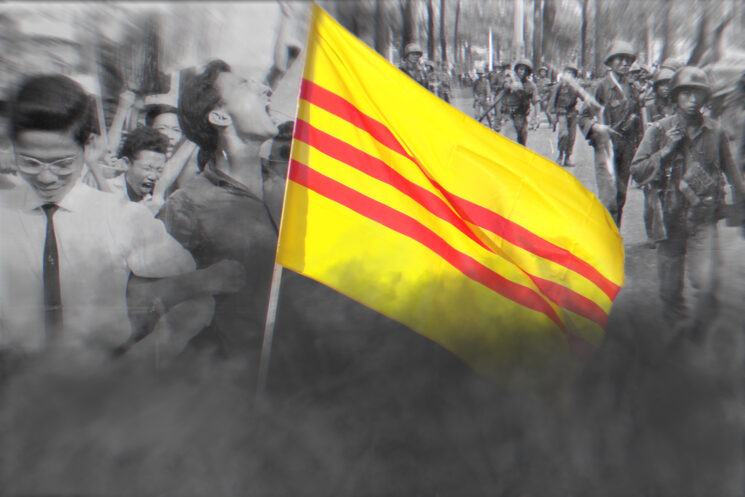
By Uy Pham
On November 6, Baron Broadcast News aired a segment school-wide at Fountain Valley High School regarding the various ways that different communities celebrate Thanksgiving. In the video, the Vietnamese American population was represented with the red and yellow star flag — the flag of the current government of Vietnam.
However, this raises questions regarding the contrasts between that flag and the yellow and red striped flag of South Vietnam, along with which flag should be displayed as the true representation of the Vietnamese American community.
South Vietnam, officially known as the Republic of Vietnam, fell when Vietnamese Communists, also known as the Viet Cong, seized Saigon on April 30, 1975.
More than 2 million Vietnamese fled the country following the event known as the Fall of Saigon. Treacherous journeys overseas included overcrowded vessels, roaming pirates and the wraths of Mother Nature. Approximately 500,000 people gave up their lives on land and sea in their escapes from the brutal communist regime.
The majority of the South Vietnamese population remained in their homeland. A new government had been instituted, one led by the Viet Cong and their ideals.
Many Vietnamese were forced to move to labor on collective farms. Hundreds of thousands of South Vietnamese citizens were rounded up and placed into “re-education camps” run by the new government.
Anyone affiliated with the United States of America, South Vietnam and its allies were held against their will in these re-education camps. Among the indoctrination and forced confessions, prisoners were also subjugated to unbearable labor conditions ranging from agriculture to minefield sweeping, where starvation, disease and malnourishment ensued. In addition, prisoners suffered tremendous amounts of emotional and mental distress from the abuse upon them.
It was not until the Humanitarian Operation Program began in 1981 that these detainees and their families could leave an oppressive government. Through an agreement between Vietnam and the United States, Vietnamese political refugees could apply for resettlement in various countries.
As a result, more than 1.3 million Vietnamese immigrants have resided in the United States.
Take a stroll into Little Saigon, the heart of the Vietnamese-American population in Orange County and in the United States. The yellow flag with three red stripes, the flag and symbol of South Vietnam, hangs high in the various buildings and structures within the community. To the Vietnamese American population, this flag represents their proud Vietnamese heritage.
When one Googles “Vietnam flag,” the top search result is a red flag with a central yellow star. The only emoji that shows up on the iPhone’s keyboard is this flag, which represents Vietnam’s current government.
However, to the Vietnamese American population, this flag represents painful memories of brutality, oppression, and inhumanity rooted from the actions of the communist regime.
The red flag inflicts a deep emotional wound on the Vietnamese past. A remembrance of those who died on the journey to a better opportunity. A symbol of those who suffered and even lost their lives within the brutal suppression of re-education camps. Feelings of sadness emerge from the loss of a country, freedom, humanity and in many cases, the lives of family members and loved ones.
The South Vietnam flag represents the Vietnamese American heritage and cultural identity. The identity of many Vietnamese Americans who were forced to flee a life of suffering in the quest for freedom.
It is the symbol we have placed in the communities built here, ones constructed after abandoning a fallen dream. A flag we have raised to recognize the opportunities and hardship we overcame, and the strong sense of cultural heritage we still feel of a country fallen to tyranny.
Multiple California governors have recognized the meaning of the South Vietnam flag. In 2006, Governor Arnold Schwarzenegger signed Executive Order S-14-06, proclaiming the South Vietnam flag as a symbol of resilience, freedom and democracy against tyranny. In 2011, Governor Jerry Brown affirmed this symbol of the Vietnamese-American community.
The next time you choose to remember and recognize the vibrant Vietnamese American community, an abundant population within the United States of America, keep in mind what flag represents our heritage and cultural identity. Despite the red and yellow star flag’s official national status, remember what each flag represents: one represents brutality, and one represents freedom.
Don’t choose the red flag with a yellow star and discount the brutality, suppression and abuse faced by the South Vietnamese after the Viet Cong took control of Saigon. Don’t forget the lives of those who suffered escaping for freedom or those who remain under the new regime.
Instead, choose the flag of South Vietnam, the flag of yellow background and three horizontal red stripes. A symbol of the journeys toward freedom that many Vietnamese Americans risked their lives for, and a symbol of the cultural identity that we have established in the United States of America.
We are all part of a Vietnamese-American community who share a common goal and dream of seeking freedom and opportunities. The red and yellow star flag acts as a constant reminder of our pain and why we are all seeking freedom, even still to this day, in a new home country.
The brutality of that red and yellow star regime continues in the country today, and that government is one that our community of Vietnamese Americans will never be represented by.





